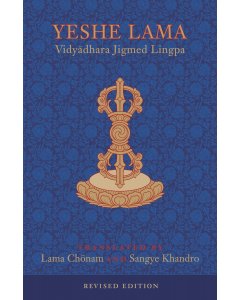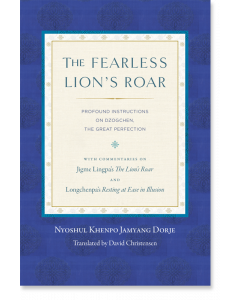See Also: Dudjom Tersar | Longchen Nyingtig | Namcho & Palyul
___________________
Guru Rinpoche | Mandarava | Rongzompa | Longchenpa | Jigme Lingpa | Patrul Rinpoche |
Sera Khandro | Mipham Rinpoche | Dilgo Khyentse | Dudjom Rinpoche
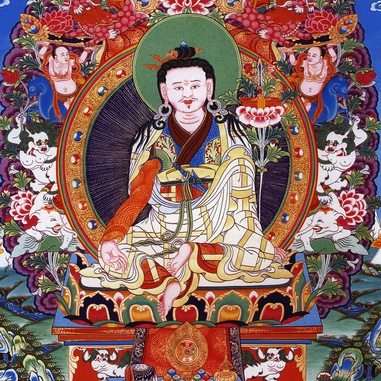

Rigdzin Jigme Lingpa (1730–1798) was a great master of the Nyingma tradition of Tibetan Buddhism. The root of the Khyentse lineage, he was a tertön, or discoverer of treasure teachings, and revealed the Longchen Nyingtik, one of the most important cycles of meditative practice in the Nyingma school.
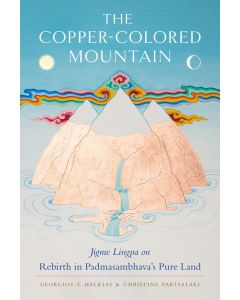
By Jigme Lingpa
Translated by Georgios T. Halkias
Translated by Christina Partsalaki
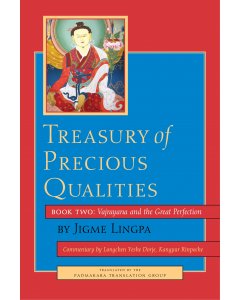
By Longchen Yeshe Dorje, Kangyur Rinpoche
By Jigme Lingpa
Translated by Padmakara Translation Group
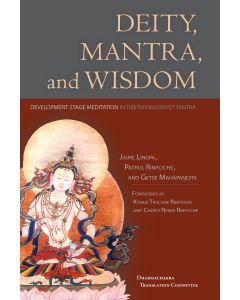
Foreword by Chokyi Nyima Rinpoche
By Patrul Rinpoche
Foreword by Kyabje Trulshik Rinpoche
By Jigme Lingpa
By Getse Mahapandita Tsewang Chokdrub
Translated by Dharmachakra Translation Committee
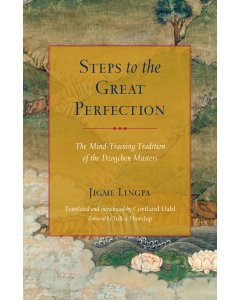
By Jigme Lingpa
Contributions by Garab Dorje
Contributions by Longchenpa
Translated by Cortland Dahl
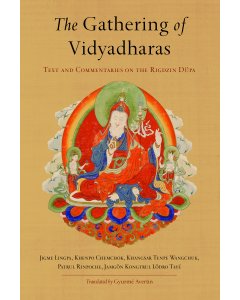
By Jigme Lingpa
By Patrul Rinpoche
By Khenpo Chemchok
Translated by Gyurme Avertin
By Khangsar Tenpa'i Wangchuk
Contributions by Jamgon Kongtrul Lodro Taye
By Jamgon Kongtrul Lodro Taye
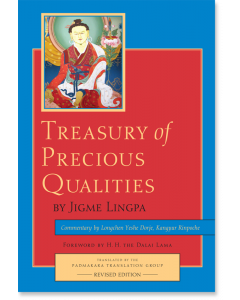
By Longchen Yeshe Dorje, Kangyur Rinpoche
Translated by Padmakara Translation Group
Foreword by H.H. the Fourteenth Dalai Lama
By Jigme Lingpa
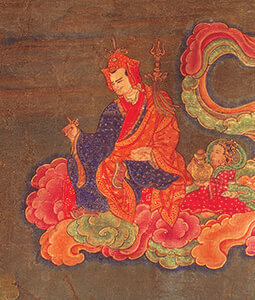
The Guhyagarbha Tantra: A Reader's Guide to the Glorious Secret Essence

See Also: Dudjom Tersar | Longchen Nyingtig | Namcho & Palyul
___________________
Guru Rinpoche | Mandarava | Rongzompa | Longchenpa | Jigme Lingpa | Patrul Rinpoche |
Sera Khandro | Mipham Rinpoche | Dilgo Khyentse | Dudjom Rinpoche
As Kyabje Dungse Thinley Norbu Rinpoche has said, "The ultimate source for the entirety of Sutra and Tantra is the King of Tantras, The Guhyagarbha, Glorious Secret Essence." The Guhyagarbha Tantra summarizes the heart of all eighteen great Mahayoga tantras and is the general tantra of the category of enlightened mind. This Secret Essence Tantra is the most advanced and extensively studied tantra within the Nyingma lineage; and its twenty-two chapters elucidate how to correctly view the ground, traverse the path, and ultimately reach the result-fully enlightened buddhahood.
The tantra of the Glorious Secret Essence (the Guhyagarbha Tantra) extracts the essence of the eighteen Mahayoga tantras and is also the general tantra of enlightened mind. The twenty-two chapters of this tantra describe the three tantras of the ground path and result and explain the topics of tantra needed to perfect the practice.
Studying the Secret Essence is crucial for all who seriously wish to learn any of the three inner tantras, as Mahāyoga is the foundation of all the inner tantras and the Secret Essence is the root tantra of Mahāyoga. The great Mipham writes, “One must learn the tantric trainings by relying on Mahāyoga, as it teaches the ground, path, and result of all tantric cycles.” He also says, “Correct understanding of the visions of all three inner tantras depends on understanding the Secret Essence.” The Secret Essence is also the source of numerous teachings on the one hundred peaceful and wrathful deities, one volume of which—the Tibetan Book of the Dead—is quite popular in the West.
Please note that many of the books listed here require that you have received certain teachings and/or empowerments. Please see the respective book pages for details. Until you receive them, the books are best used as something for your shrine.
$150.00 - Hardcover
By Longchenpa
Translated by Lama Chonam and Sangye Khandro
The twenty-two chapters of this tantra elucidate how to correctly view the ground, traverse the path, and ultimately reach the result—fully enlightened buddhahood.
The first part of this book includes the Tibetan and English translation for the root tantra itself.
The second part of this volume is a translation of the extensive com1nentary on The Guhyagarbha Tantra called Thorough Dispelling of Darkness throughout the Ten Directions written by the omniscient Longchenpa, who was an actual emanation of Samantabhadra. His word-for-word commentary gives uncommon explanations regarding all stages of Vajrayana practice, including comprehensive teachings from the Dzogchen point of view on how to practice and accomplish the path to enlightenment. The author includes complete explanations of the peaceful and wrathful mal).cJalas, as well as practical instructions needed to attain the four states of vidyadharahood.
By Jamgon Mipham Rinpoche
Translated by Lama Chonam and Sangye Khandro
This commentary on the Secret Essence by Mipham Rinpoche illuminates all the crucial points of the entire path of Secret Mantra Vajrayana. The teachings contained in Essence of Clear Light are not only useful for dharma practice in general but are especially applicable for the practice of the three innermost yogas of Secret Mantra. For that application there are the eleven topics well known throughout the teaching of tantra that are clearly elucidated in this text. The topics are: the nature as it is, the view immovable, samadhi forsaking the pass, conduct the array, mandala traversing the stages, empowerment not transgressing, samaya pursuing the goal, accomplishment presentation to the places, offerings the manifestation, enlightened activity binding, mudra and recitation, and mantra. These topics are the crucial points of the path through which the common and supreme siddhis are brought to fruition.
As Mipham Rinpoche points out in this commentary, if these topics are not understood, then there is no other method through which the final result on the path can be achieved. In brief, this excellent text brings an undeniable understanding that all dualistic phenomena arising from the ignorance of grasping and fixating are primordially pure as the truth of inseparable purity and evenness, or the great dharmakaya. Aside from realizing this view, there is no other method through which to receive the genuine wisdom transmission of the lineage of the vidyadhara masters. This doctrine of the great secret, the Guhyagarbha Tantra is the heart essence of a million wisdom dakinis and the path that was traversed by the accomplished vidyadharas of India and Tibet.
$95.00 - Hardcover
$34.95 - Hardcover
By Mipham Rinpoche
Translated by the Dharmachakra Translation Committee
Mipham's explanation of this text, here translated for the first time, is one of the most celebrated commentaries on the Tantra of the Secret Essence, which today occupies an important place in the tantric curriculum of Tibetan monastic colleges. Luminous Essence is a specialized guide meant for initiated tantric practitioners. To fully appreciate and assimilate its message, it should be studied under the guidance of a qualified teacher by those who have received the appropriate empowerments, reading transmissions, and oral instructions.
By Dodrupchen Jigme Tenpa'i Nyima
Translated by Lama Chonam and Sangye Khandro
As the author Dodrupchen Tenpa'i Nyima himself has said, this glorious Secret Essence Tantra possesses eight great features. It is the king of all tantras, pinnacle of all vehicles, origin of all doctrines, general commentary for all scriptural transmissions, core wisdom, intent of all the victorious ones, ultimate state of all results, path that all tathagatas have embarked upon, and great path of all true practitioners. Commentary to the Guhyagarbha Tantra, the Key to the Precious Treasury, synthesizes the meaning of all eighteen Mahayoga tantras from the perspective of the author's personal realization and authoritative scholarship. As the means through which serious practitioners can realize the truth of inseparable purity and evenness, this teaching is the guide for knowing how to internalize the Secret Mantra path of the generation and completion stages.
Th ere are a number of major commentaries3 on the Secret Essence; however, Ihas become one of the four most popular commentaries. It was written by the Third Dodrupchen, a highly
respected scholar and adept. Referring to the Third Dodrupchen’s famous treatise about memory, the Th irteenth Dalai Lama noted, “Today, a writer of this quality is very rare in this land.” The present Dalai Lama has frequently praised the Third Dodrupchen’s writings, too. He says, “Reading Dodrupchen was as if he were stroking my head in confirmation, giving
me confidence that my insight was not unfounded.”
$95.00 - Hardcover
$59.00 - Hardcover
**Note: Books 15-17 is purchased as a single item but is in fact two separate books that ship wrapped together.
By Choying Tobden Dorje
Translated by Gyurme Dorje
Contributions by Lama Tharchin
Two of the books of the Complete Nyingma Tradition, the masterpiece and most extensive presentation of the Nyingma thought and practice available in English, are focused on the Guhyagarbha Tantra. The two books present the entire text of the Guhyagarbha Tantra, in Tibetan and English, together with the interlinear sections of one of its most important commentaries, Dispelling the Darkness of the Ten Directions, by the outstanding fourteenth-century master Longchen Rabjam. Also included is Choying Tobden Dorje’s rewriting of Candragomin’s inspirational Extensive Commentary on the Sublime Litany of the Names of Manjushri.
$24.95 - Paperback
By Ringu Tulku
Ringu Tulku provides several pages on the Guhyagarbha Tantra in his elucidation of the Ri-Me (Rimé) tradition, including its transmission from King Ja to his son Kukuraja to Lialitavajra and Buddhaguhya, who wrote the famous commentary, The Commentary on the Distinctions. Other Indian commentaries include those by Chandragomin and Guru Rinpoche (The Great Explanation by Padma).
The next section describes the Guhyagarbha teaching lineages in Tibet, highlighting masters like Vimalamitra, Ma Rinchen Chok, Nyak Jnanakumara, Nupchen Sangye Yeshe, Katog Dampa Desheg, Rongzompa, Longchenpa, the Zur lineages, and many more.
The following section delves into the three styles of teaching on the tantra:
$22.95 - Hardcover
By Padmasambhava and Mipham Rinpoche
A Garland of Views presents both a concise commentary by the eighth-century Indian Buddhist master Padmasambhava on a chapter from the Guhyagarbha Tantra on the different Buddhist and non-Buddhist philosophical views, including the Great Perfection (Dzogchen), and an explicative commentary on Padmasambhava’s text by the nineteenth-century scholar Jamgön Mipham (1846–1912).
Padmasambhava’s text is a core text of the Nyingma tradition because it provides the basis for the system of nine vehicles (three sutra vehicles and six tantra vehicles) that subsequently became the accepted way of classifying the different Buddhist paths in the Nyingma tradition.
Mipham’s commentary is the one most commonly used to explain Padmasambhava’s teaching. Mipham is well known for his prolific, lucid, and original writings on many subjects, including science, medicine, and philosophy, in addition to Tibetan Buddhist practice and theory.
$29.95 - Paperback
By Rongzom Chokyi Zangpo and Heidi Koppl
This is a translation and study of the great Rongzom Mahpandita's Establishing Appearances as Divine which is usually described in the present-day Nyingma tradition as a commentary on the Guhyagarbha Tantra. If one accepts this classification, it would lend further testimony to Rongzom’s general fondness for the Guhyagarbha teachings and his attempt to validate these teachings through the style of discourse usually associated with the classical dialectical approach. Considering that the initial thesis of Establishing Appearances
as Divine follows almost verbatim that of Padmasambhava in his Garland of Views, a treatise that itself is based on the Guhyagarbha, one may reasonably conclude that the
traditional classification of Establishing Appearances as Divine as a text pertaining to the Mahāyoga class of Tantra is valid.
$34.95 - Paperback
By Mipham Rinpoche and Douglas Duckworth
The Guhyagabha Tantra (or Secret Essence Tantra) appears throughout this work since it is so central to the Nyingma tradition.
Here is an excerpt from one section, but there is a lot more in the book.
The Secret Essence Tantra is the most important tantra in the Nyingma tradition. It comes from a group of eighteen tantras known as the Māyājāla (“the magical net”). The metaphor of the net is significant; it is also used in a sutra where we find the famous image of the jeweled net of Indra, which is said to extend across the universe. It has a jewel at each point where the threads cross, and each jewel reflects each and every other jewel in the entire net. The net is a metaphor for the universe: the whole universe is contained within each single part. The finite is part of the infinite, while the infinite is constituted by and reflected within the finite. The metaphor aesthetically illustrates an important theme in Great Vehicle Buddhism in general and in tantra in particular, namely, the inseparability or unity of nirvana and samsara. Nirvana is not held as somewhere else out there, separate from samsara, like a separate and transcendent infinity apart from the finite. Rather, nirvana is to be discovered within the
nature of samsara. Likewise, the ultimate truth is not to be found separate from the relative truth but within it.In addition to containing the metaphor of the net, the Secret Essence Tantra also extends a theme of universal buddha-nature—the doctrine that all beings have the innate potential to become buddhas—to embrace a view that everything is already the buddha. Thus, the Secret Essence Tantra reveals an important turn within Buddhist thought: a shift from Buddhanature (tathāgata-garbha), the universal potential for enlightenment, to the secret-nature (guhya-garbha), the affirmation of universal enlightenment right now. This turn toward an immanent absolute is a major feature of the tradition of tantra in Tibet, as well as in Buddhist traditions across East Asia.
$34.95 - Paperback
By Jigme Lingpa with commentary by Longchen Yeshe Dorje (Kangyur Rinpoche)
Translated by Padmakara Translation Group
The second volume of Jigme Lingpa's masterpiece relies heavily on the Guhyagarba Tantra in its presentation of Vajrayana and Dzogchen. It quotes liberally from it throughout.
$34.95 - Paperback
By Herbert V. Guenther
World-renowned Buddhist scholar Herbert V. Guenther here offers an early study study of the Dzogchen or Ati tradition of the Nyingma school of Tibetan Buddhism. Matrix of Mystery explores man's ability to preserve as well as transmit essential insights into the structure of reality.
Utilizing a key root Buddhist scripture, the Guhyagarbha ("Matrix of Mystery"), along with dozens of commentarial Tibetan textual sources, Guenther presents the most profound teachings of the Buddhist tradition, which represent the culmination of religious thought and practice in Tibet. In relating these teachings in modern scientific and humanistic perspectives, he demonstrates how, in many cases, the traditional religious and modern secular perspectives on the nature of reality interface.
Professor Guenther discusses the mandala and the deities that reside therein; the organizing principles of body, speech, mind, quality, and action, the three bodies of the buddha (trikaya); the inseparability of prajna and skillful means; and the complex field of Buddhist iconography. Throughout, quotations from numerous Tibetan sources are used to illustrate various teachings. His book will appeal to any serious student of Tibetan Buddhism.
Note: You may also find Khenpo Palden Sherab's Splendid Presence of the Great Guhyagarbha: Opening the Wisdom Door of the King of All Tantras a useful resource.

Tibetan Buddhist Books in 2022: A Review

See our other Year in Review Guides:
Theravada/Pali/Insight | Zen and Chan | Tibetan Buddhism
Yoga | Personal Development | Kids Books
Receive a 30% discount on these titles through January 2nd using code 2022YE at checkout
We are very happy to share with you a look back at our 2022 books for those who practice in the Tibetan tradition.
Jump to: Reader Guides | Books | Books for Kids | Audiobooks | Forthcoming Books
By Pema Chodron
In How We Live Is How We Die, Pema Chödrön shares her wisdom for working with this flow of life—learning to live with ease, joy, and compassion through uncertainty, embracing new beginnings, and ultimately preparing for death with curiosity and openness rather than fear.
Poignant for readers of all ages, her teachings on the bardos—a Tibetan term referring to a state of transition, including what happens between this life and the next—reveal their power and relevance at each moment of our lives. She also offers practical methods for transforming life’s most challenging emotions about change and uncertainty into a path of awakening and love. As she teaches, the more freedom we can find in our hearts and minds as we live this life, the more fearlessly we’ll be able to confront death and what lies beyond. In all, Pema provides readers with a master course in living life fully and compassionately in the shadow of death and change.
By Khentrul Lodrö T'hayé Rinpoche
A modern guidebook based on ancient Buddhist techniques for transforming emotional pain, anxiety, and stress into complete mental well-being that benefits us and the people around us.
We’ve all heard platitudes about cultivating love and compassion, but how can we really develop these qualities in ourselves and—crucially—share them in our world? The Power of Mind provides a proven path.
Khentrul Rinpoche teaches that regardless of what’s unfolding in our lives, our route to freedom lies in our minds—and how we work with them. A thousand years ago, the Indian saint Atisha endured great hardship to bring the Buddha’s teachings to Tibet, where they flourished. This book introduces a primary text that emerged—the Seven Key Points of Mind Training.
Khentrul Rinpoche learned these practices from teachers who faced innumerable hardships during the Cultural Revolution. Rinpoche was moved by the ability of these teachers who, like alchemists, were able to follow these techniques to transform their suffering into something good.
The Power of Mind shares instructions that we can work through, one by one—from recognizing the preciousness and impermanence of our lives to avoiding drama and self-centeredness—along with meditations and practices. This wisdom is accessible to anyone seeking inner transformation—whether Buddhist or not. As Khentrul Rinpoche states, “Peace and happiness can be attained, but not by searching for something in the outside world. They start within us then extend out to the entire globe.”
Just as the archetypal hero possesses the heart to face trials and tribulations for the sake of helping others, the bodhisattva has a remarkable resolve to free others from suffering so that all may achieve true happiness and awakening. Through each challenge, the Buddhist hero of compassion develops rich inner qualities that empower them to be of true benefit to others.
In The Heroic Heart, Jetsunma Tenzin Palmo, an esteemed spiritual teacher with a lifetime of experience, illuminates the heart of Mahayana Buddhism—bodhichitta—describing it as “the selfless expression of boundless compassion.” Jetsunma uses as a touchstone the famous Tibetan Buddhist text The Thirty-Seven Verses on the Practice of a Bodhisattva. Here, she reveals how to become such a compassionate hero, the bodhisattva in training, and helps us to face the uncertain tides of the world, however joyful or dangerous, with a deep wish to find meaning and uncover the ultimate heart of wisdom and compassion.
By Phakchok Rinpoche and Sophie Wu
Foreword by Daniel Goleman
The notion of dignity is crucial to the question of how best to live a meaningful and fulfilling life, particularly for today’s environment in which so many of us experience self-doubt, low self-esteem, and feelings of being trapped by anxiety, dissatisfaction, or even success. How, in such a circumstance, can we gain authentic and unshakeable dignity? In Awakening Dignity, Phakchok Rinpoche draws from the Tibetan Buddhist wisdom tradition to offer a unique and fresh approach to answer this question.
From the Buddhist perspective, dignity is an inherent quality of fundamental wholeness and completeness that we all naturally possess: our true nature is pure and our heart is noble. In this guide, Phakchok Rinpoche shows how knowing that we are whole and complete already—and gaining trust and certainty in that understanding—can counteract the common feeling that we are not enough, that something is missing.
Gaining unwavering trust in ourselves protects us from life’s ups and downs. With genuine dignity, we are not riddled with uncertainty, anxiety, or self-doubt. Rather, we are able to face any circumstance with confidence, clarity, and compassion. Through reflections, examples, and simple meditations—such as embracing adversity and practicing compassion—Awakening Dignity provides all the tools necessary to fully embody our fundamental dignity.
By Bruce Newman
A real-world guide to the seemingly other-worldly tradition of Tibetan Buddhism. Millions outside of Asia become curious about Tibetan Buddhism through hearing and being touched by the words of the Dalai Lama, reading a book about Tibet, seeing images, or watching films.
Many who are curious about Buddhist ideas eventually find themselves reaching a point where they are exposed to aspects of Tibetan Buddhism but are unsure what participating in the tradition and its practices entails. In this warm, candid, and practical guide from a longtime practitioner, Bruce Newman offers guidance on the role of a teacher and finding one that is a good match; a clear explanation of what initiation means; how to approach practice in community; and a comprehensive outline of Tibetan Buddhist practices done both on and off the cushion. Special emphasis is placed on the potential pitfalls—and the marvelous benefits—of the guru-disciple relationship.
This a substantially updated edition with new material from the author.
By Anam Thubten
In Into the Haunted Ground, Anam Thubten invites us to embrace every aspect of our lives, from the most difficult to the most joyful. For those of us who feel caught in endless anxious thoughts and stuck in personal relationships, Anam Thubten offers a direct and practical approach to dismantle our conceptual fixations, reveal the deeper habits that motivate us, and step into the immediate open spaciousness that can heal ourselves and the world.
Weaving together personal stories with philosophical explanations, Anam Thubten offers swift and straightforward methods to cut through old habits that no longer serve our best interests or reflect our true nature. Suitable for beginners and experienced practitioners alike, this book presents the core lessons of the Tibetan practice of Chöd as a fundamental wisdom that is accessible to any of us willing to enter the “haunted grounds” of our own minds.
In Kyabje Garchen Rinpoche’s first major collection of tantric teachings, he offers a complete manual for the visualization and supplication of the deity Vajrakīlaya. This ancient tantric practice centers on familiarizing oneself with the wrathful deity as a method for traversing the path to enlightenment. With clear instructions and insightful commentary, Garchen Rinpoche highlights the cultivation of bodhicitta at every stage of the path. This comprehensive guide to deity practice by one of the greatest living Tibetan meditation masters will support practitioners of all experiential levels in reuniting with their own awakened nature.
By Karma Chagme
By Rigdzin Kunzang Sherab
Tertön Migyur Dorje revealed the Namchö treasure teachings while in a three-year retreat that began when he was only thirteen. The Namchö treasures later became the main teachings and practices of the Palyul Nyingma lineage of Vajrayana Buddhism.
This book brings together two texts that have inspired countless practitioners in this lineage. The first text tells the life story of Migyur Dorje. It was composed by Karma Chagme, who first recognized the seven-year-old Migyur Dorje as an exceptional tulku and tertön and prepared him to be a major treasure revealer. In telling this story, Karma Chagme reveals his love and concern for the precocious young boy. He weaves an inspiring and captivating tale of wonder and magic, enlightened deities and threatening demons, prophetic dreams and extraordinary visions.
The second text is the famous commentary on the Namchö preliminary practice by Rigdzin Kunzang Sherab, Migyur Dorje’s main student and the first throne holder of the Palyul lineage. It explains the foundational practice that should be completed before pursuing more advanced tantric practices: the four contemplations that turn the mind to dharma and the fivefold practice of taking refuge, arousing bodhichitta, mandala offering, Vajrasattva purification, and Guru Yoga.
By Thinley Norbu Rinpoche
While Thinley Norbu Rinpoche was known as being a yogi and teacher of the Secret Mantra tradition par excellence, his scholarship was second to none. The first half of this work is perhaps one of the clearest presentations of how the teachings of the three yānas of Buddhism came into being, from the previous Buddhas to the coming of Buddha Śākyamuni, to the three councils of the Śrāvakayāna, Bodhisattvayāna, and through the Vajrayāna and Dzogchen.
The Mahayāna receives great detail, with accounts of the lives and importance of figures like Dignāga, Dharmakīrti, Nāgārjuna, Vasubandhu, Āryadeva, Asanga, Vasabandu, Guṇaprabha, Shantideva, Candragomin, Candrakīrti, and more.
The Vajrayāna section gives an account of the tantras of both the Nyingma and Sarma traditions. There is a clear and detailed account of great Tantric figures of India and Tibet as well as the great figures and texts from the Nyingma, Kadam, Sakya, Kagyu, Gelug traditions.
The second half of the book is focused on the Dudjom lineage in particular, whose series of eighteen primary incarnations weaves its way through all the epochs and traditions described in the first half.
By Longchenpa and Khangsar Tenpa'i Wangchuk
Translated by Padmakara Translation Group
Modern scholar and Nyingma master Khangsar Tenpa’i Wangchuk composed this first and only commentary on the fourteenth-century Buddhist master Longchenpa’s essential text, The Precious Treasury of the Fundamental Nature. The root text establishes the definitive view of the secret class of pith instructions of Dzogchen, the Great Perfection. Tenpa’i Wangchuk’s word-commentary elucidates the nature of phenomena adhering closely to the internal structure of Longchenpa’s verses, clearly presenting the four vajra principles of the nature of phenomena: nonexistence, evenness, spontaneous presence, and single nature.
The Padmakara Translation Group has provided a clear and fluid new translation of Longchenpa’s root text. The commentary by Khangsar Tenpa’i Wangchuk is here translated for the first time, commencing an extended project to render his entire collected works in English. This is an invaluable resource for students of Buddhism who wish to deepen their understanding of the nature of mind and phenomena as presented in the Great Perfection tradition.
By Shechen Gyaltsap Gyurme Pema Namgyal
Translated by Padmakara Translation Group
A Chariot to Freedom is one of the most beloved presentations of the preliminary practices, or ngöndro, that form the foundation of the Vajrayana Buddhist path. This set of practices, common to all schools of Himalayan Buddhism, is what nearly every practitioner begins with, yet it also constitutes a complete method in and of itself. Although the preliminary practices are considered a prerequisite for further teachings and initiations into other practices, many of even the most accomplished masters continue to engage in them every day.
Most of the other excellent works on these foundational techniques are specific to a particular tradition, but this text is widely considered to be exemplary, in part, because it is applicable to all traditions of ngondro. Drawing from the original words of the Buddha in the sutras and from later treatises by such masters as Nagarjuna, Shantideva, and Guru Padmasambhava, Shechen Gyaltsap’s commentary is a wonderfully curated anthology of Buddhist teachings on the preliminary practices of Vajrayana Buddhism. It covers the thoughts that turn one’s mind away from ordinary pursuits and toward enlightenment, taking refuge, arousing the mind set on enlightenment (bodhichitta), purification, mandala offering, and Guru Yoga.
Shechen Gyaltsap explains why each practice is beneficial and provides profound and eminently useful guidance for practitioners, while simultaneously transmitting the wisdom of generations of Buddhist masters.
By Jigme Lingpa
Translated by Georgios T. Halkias and Christina Partsalaki
The Copper-Colored Mountain is the pure land of Padmasambhava, the Indian master who brought Buddhism to Tibet. One way in which Buddhist practitioners may be reborn in this pure land is by making aspiration prayers. This work includes a translation of one of the most famous of these aspiration prayers, composed by Jigme Lingpa, and the authors’ verse-by-verse analysis of it. Drawing on both traditional commentaries and contemporary scholarly texts, the authors show how Jigme Lingpa encodes many features of Tibetan Buddhist tantric practice in these verses, and thus they provide a feast of meaning for tantric practitioners.
By Elisabeth A. Benard
An exploration of an extraordinary group of female meditation masters from the Sakya Buddhist tradition in Tibet whose determination and accomplishments can serve as a great example for meditators the world over.
In The Sakya Jetsunmas, Elisabeth Benard presents the first in-depth study of the great female practitioners born into the Sakya Khon family, one of the most prestigious families of wisdom-holders in the Tibetan Buddhist tradition. These jetsunmas (“venerable women”) received the same training as their brothers, taught some of the most famous male lamas of their times, and transmitted wisdom from one female adept to another. Benard did extensive research in Tibet, India, and Nepal, collecting texts, diaries, and many interviews. In this groundbreaking book, the hidden world of the Sakya Jetsunmas is finally revealed.
By Rachael Stevens
Tara is one of the most celebrated goddesses in the Buddhist world, representing enlightened activity in the form of the divine feminine. She protects, nurtures, and helps practitioners on the path to enlightenment. Manifesting in many forms and in many colors to help beings, Tara’s red form represents her powers of magnetization, subjugation, and the transformation of desire into enlightened activity. She is considered to be particularly powerful in times of plague and disharmony.
This comprehensive overview focuses on the origins, forms, and practices of Tara, providing the reader with insightful information and inspirations relating to the goddess. Its second part focuses on Red Tara, a powerful and liberating form of Tara that is particularly important to connect with in a time of crisis. These chapters cover various forms of Red Tara found throughout the Tibetan Buddhist world, the particular qualities she represents, and how through prayers and meditation we can embody her principles and truly benefit beings.
By Roger R. Jackson
The possibility that we have lived before and may be born again, whether as a human or in some other form of existence, continues to be a source of fascination across cultures and across millennia. Although Buddhism is one of the religious traditions best known for asserting rebirth, the history and scope of Buddhist approaches to this belief have not received comprehensive treatment—until now.
This first-ever guide to rebirth in Buddhism covers the historical context for the Buddha’s teachings on the topic; explains what Buddhists believe is actually reborn; and considers the wide range of Buddhist views about what happens after death. The author also addresses interpretations of rebirth in modern Buddhist contexts as well as the implications of recent scientific attempts to document evidence of reincarnation. It is, in short, the first truly complete overview of rebirth across major Buddhist traditions, written by a leading scholar and teacher of Buddhism.
The Treasury of Precious Instructions by Jamgön Kongtrul Lodrö Taye, one of Tibet’s greatest Buddhist masters, is a shining jewel of Tibetan literature, presenting essential teachings from the entire spectrum of practice lineages that existed in Tibet. In its eighteen volumes, Kongtrul brings together some of the most important texts on key topics of Buddhist thought and practice as well as authoring significant new sections of his own. Below you will find the three volumes we released in 2022.
Please also visit our resource guide on the Treasury of Precious Instructions where you will find a host of resources about all of the volumes, the collections' history, plus over eight hours of talks (video and audio) by some of its translators.
By Jamgon Kongtrul Lodro Taye
Translated by Malcolm Smith
The fifth volume of this series, Sakya: The Path with Its Result, is the first of two volumes that present a selection of teachings and practices from the Path with Its Result (Lamdre) practice lineage of the Sakya tradition of Tibetan Buddhism. The Sakya lineage derives from Virūpa, Dombhi Heruka, and other Indian masters, or mahāsiddhas, and passes through Gayadhara and his Tibetan disciple Drokmi Lotsāwa Śākya Yeshe (992–1072). The practice tradition centers around the teaching and transmission of the Hevajra Tantra and its subsidiary texts. In three parts, this volume includes, respectively, the root text, commentary, and outlines for the Indian mahāsiddha Virūpa’s core text the Vajra Verses; the liturgies for empowerment and offering rituals specific to a Hevajra Tantra practice lineage; and instructional manuals for practice.
By Jamgon Kongtrul Lodro Taye
Translated by Sarah Harding
Volume 11 of the series, Shangpa Kagyu, is the first of two volumes that present a selection of teachings and practices from the Shangpa practice lineage of Tibetan Buddhism. This tradition was established in Tibet by the eleventh-century yogi Khyungpo Naljor, who had received profound esoteric teachings from many great Indian masters, especially the two yoginīs Niguma and Sukhasiddhi, as well as Maitrīpa, Rāhula, and Vajrāsana. He established a monastery in the Shang region of Tibet, from which the lineage derives its name. Much of the ancient source material for these practices focuses on Dākinī Niguma’s Five Golden Dharmas: yogic practices of the Six Dharmas, nature of mind teachings called Amulet Box Mahāmudrā, meditations to integrate appearances on the spiritual path, goddess practices, and instructions to realize the deathlessness of body and mind. Also in this volume are the tantric bases of the tradition: the combined practice of the Five Tantras’ Deities and the Five-Deity Cakrasamvara practices. The six parts of this volume include source scriptures, liturgies, supplications, empowerment texts, instructions, and practice manuals.
By Jamgon Kongtrul Lodro Taye
Translated by Padmakara Translation Group
Mahāsiddha Practice, the sixteenth volume, presents a selection of teachings and practices centered on the mahāsiddhas, Indian tantric masters. The mahāsiddha Mitrayogin, whose work forms the majority of this volume, visited Tibet in the late twelfth century. His ritual texts along with instructions are here translated from Tibetan, including sādhanas, empowerments, guru yogas, authorization rituals for protector deities, and detailed compositions on Mahāmudrā practice, or resting in the nature of mind. In addition to instructions given by mahāsiddhas, this volume includes ritual practices to visualize them and transmit their blessings, beginning with a devotional text composed by Jamgön Kongtrul himself.
The Lives of the Masters series offers lively and reliable introductions to the lives, works, and legacies of key Buddhist teachers, philosophers, and contemplatives. Each volume in the Lives series tells the story of an innovator who embodied the highest ideals of Buddhism, crafted a dynamic living tradition during his or her lifetime, and transmitted a vibrant legacy of wisdom to future generations.
In 2022 we added one more addition to the LOM series: The Second Karmapa, Karma Pakshi
By Charles Manson
Karma Pakshi is considered a key figure in the emergence of the reincarnate lama tradition, a system. Born in East Tibet in the thirteenth century, Karma Pakshi himself was the first master to be named Karmapa, a lineage that continues to modern times and has millions of admirers worldwide. During his lifetime, Karma Pakshi was widely acknowledged as a mahāsiddha—a great spiritual adept—and was therefore invited to the Mongol court at the apogee of its influence in Asia. He gave spiritual advice and meditation instructions to the emperor Mongke Khan, whom he advised to engage in social policies, to release prisoners, and to adopt a vegetarian diet. After Mongke’s death, Karma Pakshi was imprisoned by the successive emperor Kubilai Khan, and much of Karma Pakshi’s writing was done while he was captive in northeast China. He was eventually released and returned to Tibet, where he commissioned one of the medieval world’s largest metal statues: a seated Buddha sixty feet high.
Centuries later, two Buddhist meditation masters, the First Mingyur Rinpoche and Chögyam Trungpa Rinpoche, were inspired by Karma Pakshi to write meditation practices that are profoundly important to contemporary Tibetan Buddhist practitioners: respectively, the Karma Pakshi Guru Yoga and the Sādhana of Mahāmudrā.
This first-ever comprehensive biography of Karma Pakshi in English reveals new information about a pivotal historical figure in the development of Tibetan Buddhism and his interactions with two Mongol emperors. Also included are translations of several newly available songs attributed to Karma Pakshi and translations of ten excerpts of his writings on reincarnation, meditation, dreams, visionary experiences, tantra, and consecration.
By Rick Fields with a new foreword by Buddhist scholar Benjamin Bogin
A modern classic unparalleled in scope, this sweeping history unfolds the story of Buddhism’s spread to the West. This fortieth anniversary edition features both new and enhanced photographs as well as a new introduction by Fields’s nephew, Buddhist Studies scholar Benjamin Bogin, who reflects on the impact of this book since its initial publication and addresses the significant changes in Western Buddhist practice in recent decades.
How the Swans Came to the Lake opens with the story of Asian Buddhism, including the life of the Buddha and the spread of his teachings from India to Southeast Asia, China, Korea, Japan, Tibet, and elsewhere. Coming to the modern era, the book tracks how Western colonialism in Asia served as the catalyst for the first large-scale interactions between Buddhists and Westerners. Author Rick Fields discusses the development of Buddhism in the West through key moments such as Transcendentalist fascination with Eastern religions; immigration of Chinese and Japanese people to the United States; the writings of D. T. Suzuki, Alan Watts, and members of the Beat movement; the publication of Zen Mind, Beginner’s Mind by Shunryu Suzuki; the arrival of Tibetan lamas in America and Europe; and the influence of Western feminist and social justice movements on Buddhist practice.
By Tenzin Wangyal Rinpoche
A new updated and expanded edition of a classic.
We spend a third of our life sleeping, and in numerous cultures throughout the world this pivotal part of everyday life is utilized as a powerful vehicle for personal insight and spiritual growth. In the Tibetan traditions of dream yoga especially, profound practices for tapping into our dreams have been cultivated over centuries—and have become renowned for their transformative power among many yogis and great Tibetan masters. Here, acclaimed dream yoga teacher Tenzin Wangyal Rinpoche reveals their secrets. In this new and revised edition of his seminal work, he brings forward his decades of practice and experience to provide step-by-step instructions on this powerful method for liberation. Including detailed illustrations for visualization, this book offers the quintessential guide for both new and adept practitioners alike.
By B. Alan Wallace
This new edition of this classic of lojong includes three new translations of Atisha’s source material including Pith Instructions on a Single Mindfulness and Pith Instructions on the Middle Way.
The purpose of lojong, a traditional Mahayana Buddhist practice of training the mind, is about transforming one’s attitude and expanding one’s sense of self to encompass the greater whole. In this modern presentation of lojong practice and Atisha’s Seven-Point Mind Training, author, translator, and Buddhist practitioner B. Alan Wallace gives readers a framework from which they may cultivate the qualities of loving-kindness, compassion, and insight while diminishing harmful habits and ways of thinking. “All of us have attitudes,” Wallace explains, and “attitudes need adjusting.” The practice of lojong is therefore presented as a method to shift our attitude away from our problems, anxieties, hopes, and fears toward an expansive sense of joy and well-being that springs from the very essence of Mahayana—bodhichitta.
And we have even more from the Tibetan tradition coming out next year from the likes of Tulku Pema Wangyal, Jamgon Kongtrul, Mipham Rinpoche, Andy Karr, and many more. So make sure you sign up for our emails so you do not miss them! Here is a sneak peek at our first 2023 release which you can pre-order now and take advantage of the discount.
If you are new to Tibetan Buddhism, this short work will help you get started with your practice; and if you are well steeped in these teachings, it will inspire and motivate you to practice them.
While accessible for beginners, this short volume conveys incredible profundity as well. Originally delivered in the form of advice to retreatants, Pema Wangyal’s teachings cover the practices found across various lineages' foundational practices. But there is a lot more here including the focus on motivation which carries through all the practices; the specifics of posture and somatic breathing; visualization and mantra; mantra of the Budhhas, the mantra of the Prajnaparamita; the practice of Tonglen, and more.
In the last part of the book, he provides guidance about the preliminary practices using as a model those from the Dudjom lineage but applicable for everyone. Pema Wangyal’s writing is suffused with warmth and tenderness throughout, making this book quite accessible and inviting to everyone.
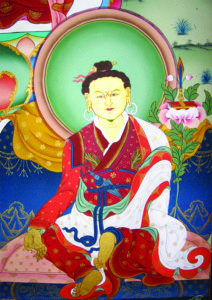
Jigme Lingpa: A Guide to His Works

See Also: Some Nyingma Lineages: Dudjom Tersar | Longchen Nyingtig | Namcho & Palyul
Guides to Other Important Nyingma Figures: Rongzompa | Longchenpa | Jigme Lingpa | Patrul Rinpoche | Mipham Rinpoche | Gesar

He is considered the incarnation of both the great master Vimalamitra and the Dharma king Trisong Detsen. After becoming a monk, he had a vision of Mañjuśrīmitra which caused him to change his monks robes for the white shawl and long hair of a yogi. In his late twenties, he began a long retreat during which he experienced visions and discovered termas. A subsequent retreat a few years later was the container for multiple visions of Longchenpa, the result of which was the Longchen Nyingthig tradition of terma texts, sadhanas, prayers, and instructions.
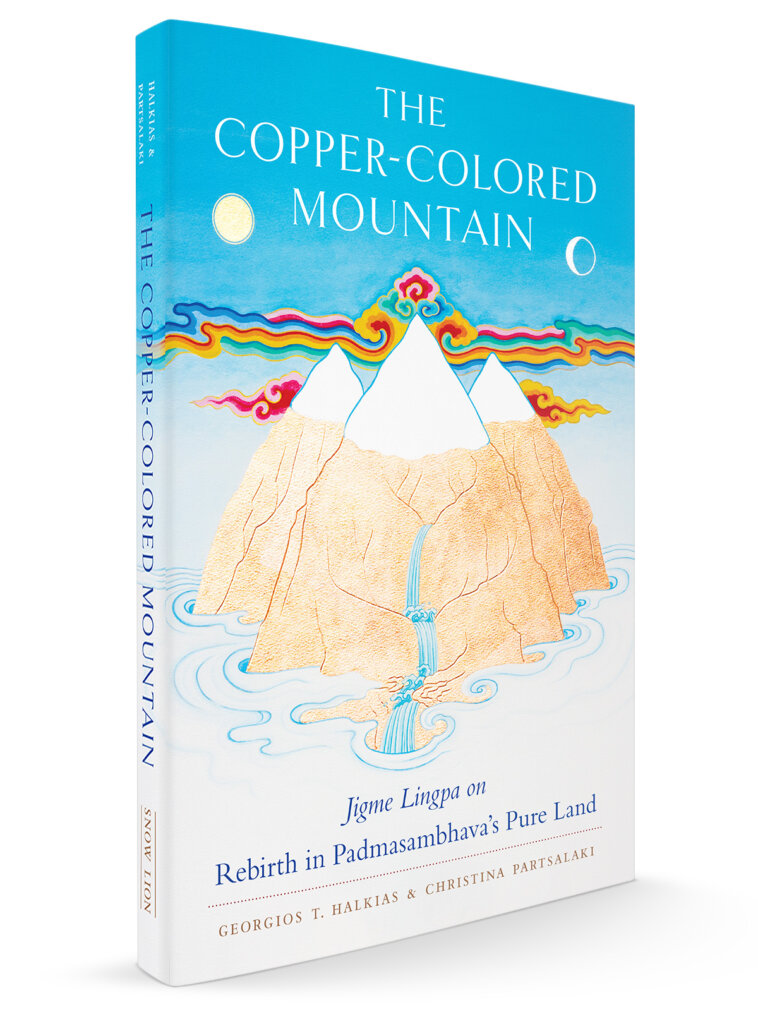
Translated and commentary by Georgios T. Halkias and Christina Partsalaki
The Copper-Colored Mountain is the pure land of Padmasambhava, the Indian master who brought Buddhism to Tibet. One way in which Buddhist practitioners may be reborn in this pure land is by making aspiration prayers. This work includes a translation of one of the most famous of these aspiration prayers, composed by Jigme Lingpa, and the authors’ verse-by-verse analysis of it. Drawing on both traditional commentaries and contemporary scholarly texts, the authors show how Jigme Lingpa encodes many features of Tibetan Buddhist tantric practice in these verses, and thus they provide a feast of meaning for tantric practitioners.
$29.95 - Paperback
By: Jigme Lingpa & Georgios T. Halkias & Christina Partsalaki
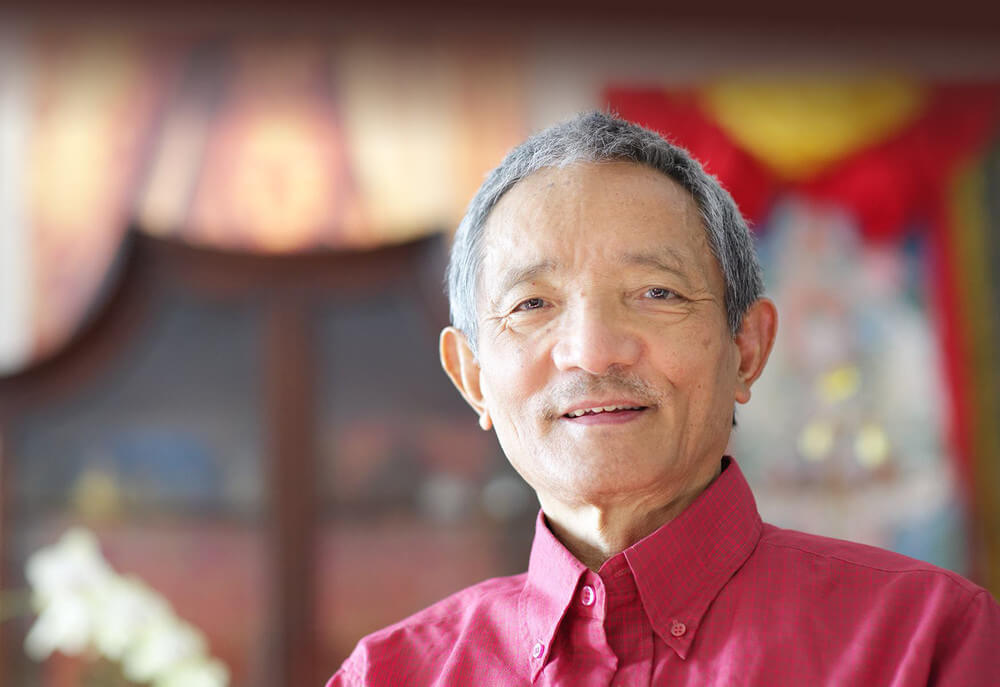
Tulku Thondup Rinpoche
What many consider the best source for understanding Jigme Lingpa's relevance, and his milieu is Tulku Thondup Rinpoche's Masters of Meditation and Miracles: Lives of the Great Buddhist Masters of India and Tibet. While the biographical coverage of him only comprises about 18 pages, this work provides the clearest scope of the overall world of Jigme Lingpa, his line of incarnations, and the tradition and branches of teachings that stem from him. Here is Tulku Thondup Rinpoche's account of his revelation of the Longchen Nyingtik.
"At twenty-eight, he discovered the extraordinary revelation of the Longchen Nyingthig cycle, the teachings of the Dharmakāya and Guru Rinpoche, as mind ter. In the evening of the twenty-fifth day of the tenth month of the Fire Ox year of the thirteenth Rabjung cycle (1757), he went to bed with an unbearable devotion to Guru Rinpoche in his heart; a stream of tears of sadness continuously wet his face because he was not in Guru Rinpoche's presence, and unceasing words of prayers kept singing in his breath.
He remained in the depth of that meditative experience of clear luminosity ('od gsal gyi snang ba) for a long time. While being absorbed in that luminous clarity, he experienced flying a long distance through the sky while riding on a white lion. He finally reached a circular path, which he thought to be the circumambulation path of Charung Khashor, now known as Bodhnath Stūpa, an important Buddhist monument of giant structure in Nepal.
In the eastern courtyard of the stūpa, he saw the Dharmakāya appearing in the form of a wisdom ḍākinī. She entrusted him with a beautiful wooden casket, saying:
For the disciples with pure mind,
You are Trisong Detsen.
For the disciples with impure mind,
You are Senge Repa.
This is Samantabhadra's mind treasure,
The symbolic scripts of Rigdzin Padma[sambhava], and
The great secret treasures of the ḍākinīs. Signs are over!
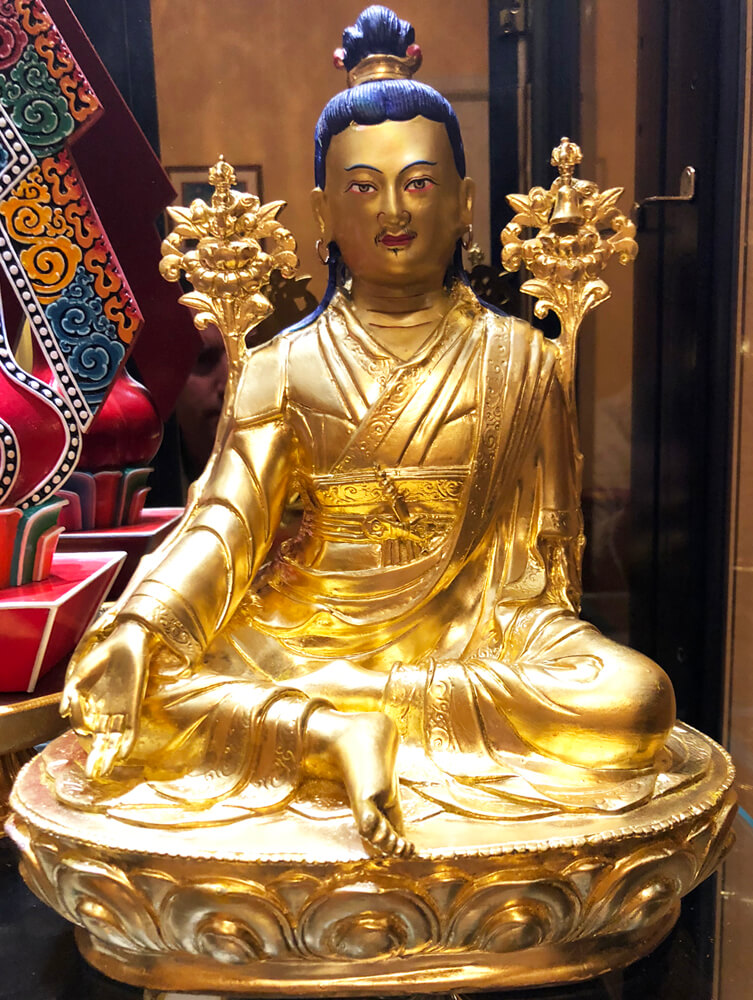
the great union of bliss and emptiness.
Thus, the Longchen Nyingthig teachings and realization, which were entrusted and concealed in him by Guru Rinpoche many centuries earlier, were awakened, and he became a tertön, the discoverer of the Longchen Nyingthig cycle of teachings."
The Treasury of Precious Qualities, in two volumes in English, is a lamrim (stages of the path) text that goes from the foundations of Buddhism all the way through Dzogchen.
Volume One covers the basics of the sūtra teachings, but in such vivid and moving detail, it stands alone in its power to move the mind. Topics include: the value of human existence; impermanence of the outer world and living beings; the paths depending on beings' capacities; karma; the sufferings of samsara; the four wheels of practice; refuge; the four boundless attitudes; bodhichitta; and the pāramitās.
Volume Two covers the Vajrayāna approach; the tantric teachings of the vidyādharas; the ground of Dzogchen; the path of the practice of Dzogchen; and the result—the kāyas and wisdoms.
These two volumes received the Shantarakshita Award for Excellence in Translation.
Steps to the Great Perfection: The Mind-Training Tradition of the Dzogchen Masters is a compilation of teachings on the seven contemplations, an ancient system of mind-training (lojong) teachings that has been preserved as part of a rare set of instructions on Dzogchen, or the Great Perfection. This book is a unique take on the practice because, although the lojong teachings of the Kadam tradition are well known, this is the first time the mind-training teachings from the Dzogchen tradition have been presented in an English translation. Most Western scholars and practitioners are unaware that such mind-training techniques even exist in Dzogchen. The contemplations themselves are vividly described, and some unfold as dramatic stories in which the meditator imagines himself or herself as the main character. Thus, they are quite accessible for beginning practitioners.
Perhaps the most famous aspect of Jigme Lingpa's Longchen Nyingtik is the ngöndro or foundational practices that all practitioners complete before going on to more specialized practices. It is this text that is the basis for works such as Patrul Rinpoche's Words of My Perfect Teacher, and the Guide to the Words of My Perfect Teacher.
Cortland Dahl compiled and translated a set of works on these practices, Entrance to the Great Perfection: A Guide to the Dzogchen Preliminary Practices, and this includes two works by Jigme Lingpa.
The first is Instructions on the Common Great Perfection Preliminaries of the Heart Essence of the Vast Expanse. This covers the four thoughts (the freedoms and advantages we have, impermanence, the shortcomings of samsara, and karma) and the benefits of liberation and serving a spiritual teacher.
The second is Instructions on the Unique Great Perfection Preliminaries of the Heart Essence of the Vast Expanse. This includes the practices of refuge, generating bodhichitta, mandala offerings, purification practice through Vajrasattva, and guru yoga.
A Guide to The Words of My Perfect Teacher
$34.95 - Paperback
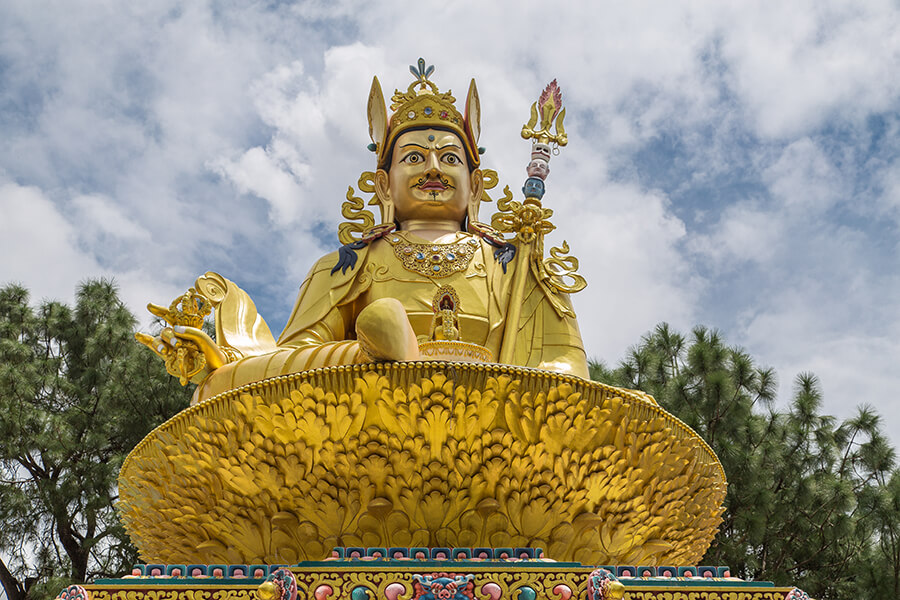
On the specific subject of guru yoga, part of Jigme Lingpa's cycle of Longchen Nyingtik includes an outer guru yoga practice entitled Wish Fulfilling Jewel. Commentaries on this by Dilgo Khyentse Rinpoche are available as Guru Yoga and in slightly longer form as Wish-Fulfilling Jewel: The Practice of Guru Yoga according to the Longchen Nyingthig Tradition (the latter is also included in the third volume of his Collected Works.)
Deity, Mantra, and Wisdom: Development Stage Meditation in Tibetan Buddhist Tantra, includes Jigme Lingpa's Ladder to Akaniṣṭha: Instructions on the Development Stage and Deity Yoga. [Note, the paperback edition releases February, 2020]. As translators Cortland Dahl and Andreas Doctor describe,
"Jigme Lingpa provides an overview of the theory and practice of the development stage, balancing philosophical inquiry with instructions on the more practical aspects of tantric meditation. The first section of the text presents the theoretical framework for development stage practice. . . .
As the basis for his presentation, Jigme Lingpa draws primarily from the Mahāyoga tantras and the commentarial literature of this tradition. Not surprisingly, his discussions often center on the Tantra of the Secret Essence, the most influential Mahāyoga scripture. He also gives considerable attention to less well-known texts, however, such as the Tantra of the Perfect Secret and the Heruka Galpo Tantra. In terms of philosophical interpretation, his views often mirror those of Longchenpa (kLong chen pa, 1308–1364), whom he met face-to-face in a series of three transformative visions and whose writings deeply influenced his own.
. . . Jigme Lingpa discusses the links between the various elements found in development stage meditation, the aspects of saṃsāra they are meant to purify, and the result that ensues once the practice has been perfected. In the second section, the focus is on practice. Here, Jigme Lingpa outlines the stages of meditation, offering practical advice on how to identify and surmount obstacles and progress in practice. The text concludes with a presentation of the fruition of development stage practice. In this section, Jigme Lingpa frames his discussion around the levels of realization and the various aspects of the enlightened state. . . .
In characteristic style, Jigme Lingpa does not shy away from difficult points and controversial topics when discussing the development stage. His tendency to tackle difficult issues head-on does not always make for easy reading, but it does offer the reader an insight into the depth and subtlety of tantric theory and the difficult issues that have occupied someof the great saints and scholars of the Vajrayāna tradition. For this reason, Ladder to Akaniṣṭha is valuable not only as a manual on the theory and practice of the development stage, but also as an introduction to the complex tantric philosophy of the Tantra of the Secret Essence and the Mahāyoga tradition as a whole."
Here is Andreas Doctor, one of the translators, discussing the book:
$29.95 - Paperback
By: Andreas Doctor & Cortland Dahl & Dharmachakra Translation Committee & Getse Mahapandita Tsewang Chokdrub & Jigme Lingpa & Patrul Rinpoche
In Red Tara: The Female Buddha of Power and Magnetism, scholar Rachel Stevens devotes five pages to Jigme Lingpa's tradition of the Twenty-One Taras, received through the lineage of Rongzompa. She discusses the history and specific iconography of this Longchen Nyingtik tradition.
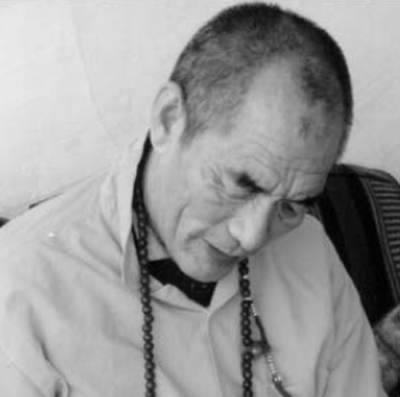 The Fearless Lion's Roar: Profound Instructions on Dzogchen, the Great Perfection by Nyoshul Khen Rinpoche includes his commentary on Jigme Lingpa’s The Lion’s Roar That Vanquishes the Diversions and Errors of Hermits Who Meditate upon the Heart Essence which is translated here in full.
The Fearless Lion's Roar: Profound Instructions on Dzogchen, the Great Perfection by Nyoshul Khen Rinpoche includes his commentary on Jigme Lingpa’s The Lion’s Roar That Vanquishes the Diversions and Errors of Hermits Who Meditate upon the Heart Essence which is translated here in full.
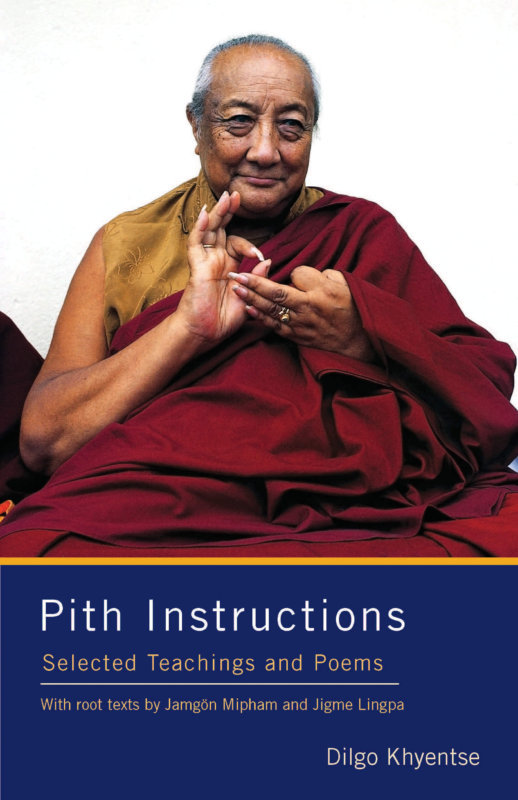
 Chögyam Trungpa Rinpoche includes a translation of the Lion's Roar in his short book Mudra: Early Poems and Songs.
Chögyam Trungpa Rinpoche includes a translation of the Lion's Roar in his short book Mudra: Early Poems and Songs.
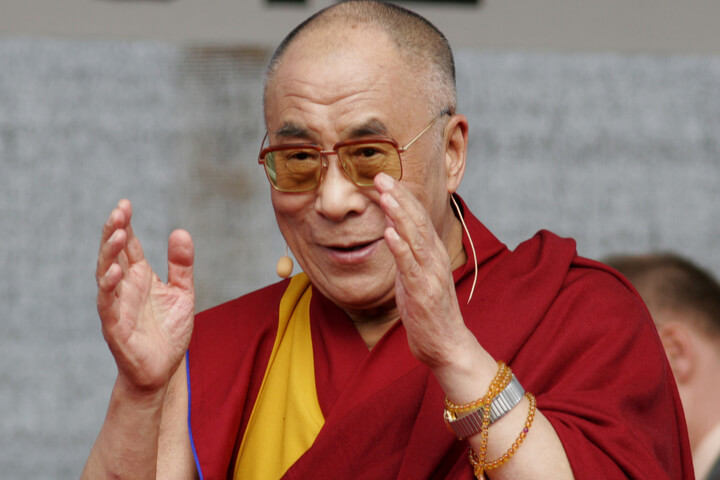
$21.95 - Paperback
By: H.H. the Fourteenth Dalai Lama & Richard Barron (Chokyi Nyima) & Patrick Gaffney & Thupten Jinpa
Heart Essence of the Vast Expanse is a collection of translations by Anne Carolyn Klein of Jigme Lingpa, Adzom Paylo, Mipham Rinpoche, and Khetsun Sangpo Rinpoche. This will include access to audio of chants that act as supports to the practices of the Longchen Nyingtik in both English (with Professor Klein and her sangha) and Tibetan by the incredibly voiced Jetsun Kacho Wangmo. Here is one of the tracks of her chanting Calling the Lama from Afar.
One of the most important practice cycles from Jigme Lingpa's Longchen Nyingtik is the "Rigdzin Düpa", or "Gathering of Vidyādharas". This sadhana, the main inner Guru sadhana, includes of ritual and meditation manuals which bring together tantra and Dzogchen. 
$39.95 - Paperback
By: Gyurme Avertin & Khenpo Chemchok & Jigme Lingpa & Patrul Rinpoche & Khangsar Tenpa'i Wangchuk
Jigme Lingpa's Yeshe Lama [a new revised and updated edition will be available in April, 2020] is the most important practice manual on the Great Perfection teachings of the Nyingma tradition. Jigme Lingpa stated, "Realization of the pure awareness that transcends the mind is the specialty of the Great Perfection." Beginning with the preliminary prerequisites, the entire Great Perfection path is spelled out clearly and succinctly in this work, which is meant to be studied and practiced by qualified practitioners who are committed to completing the prerequisites before entering the path of Dzogchen.
Note that even to open this book, one must have received empowerment and have been introduced to the nature of the mind by a qualified master. The teachings and practices taught in Yeshe Lama encompass the innermost cycle of upadesha teachings and clearly define the Dzogchen practices of trekchö, cutting through to original purity, and tögal, crossing over with spontaneous presence. These are the swift practices that can lead to the attainment of the rainbow body and the complete attainment of buddhahood, and this is the same path that has been followed by many of the great spiritual adepts of India and Tibet. Consequently, if one studies and trains in the Yeshe Lama correctly and with deepest respect and diligence, the possibility of enlightenment within one lifetime is within reach.
Note that this is a restricted text, and here is the translator of it, Sangye Khandro, explaining why:
While not by Jigme Lingpa, Anam Thubten's Into the Haunted Ground: A Guide to Cutting the Root of Suffering discusses and features Jigme Lingpa's Chöd. Part 2 moves chapter by chapter through the sections of The Dakini’s Laughter Chöd sadhana by Jigme Lingpa: refuge, bodhicitta, mandala, guru yoga, feast practice, and dedication. Even though the sections are part of a particular liturgy of a formal practice, his teachings are not exclusive to it but rather present the sadhana’s profound principles as life lessons.
A new biography is forthcoming in Shambhala Publications' Lives of the Masters series by Kurtis Schaffer. Here he is discussing why he chose Jigme Lingpa as his subject.
Another excellent source for shorter translations of Jigme Lingpa's work is the priceless Lotsawa House section on Jigme Lingpa.
And for a more academic take, Janet Gyatso takes a look at Jigme Lingpa's secret autobiography in her Apparitions of the Self: The Secret Autobiographies of a Tibetan Visionary
Finally, Sam van Schaik has made some very interesting contributions on Jigme Lingpa including an article on Jigme Lingpa's thob yig, "a genre of writing in which the author establishes the lineage for each of the texts for which he holds transmission" as well as a scholarly analysis of his collected works.
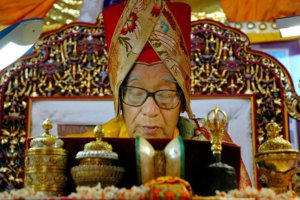
The Role of the Teacher in Tibetan Buddhism: A Reader's Guide to the Teacher-Student Relationship

To truly understand Tibetan Buddhism, one must come to grips with the unique role of the teacher, the dynamics of the teacher-student relationship, and the possibilities that having a teacher can open up.
Tibetan Buddhism is composed of the Vajrayana or Tantric teachings on top of a foundation of the Sutrayana (vehicle of the Sutras), the core teachings of what are sometimes called the Sravakayana and the Mahayana. In the context of the Sutrayana, a relationship with a teacher roughly maps to the categories of a pratimoksha master and a master of the bodhisattva vows, but there is a wide scope of possibilities and overlap within these roles. The teacher imparts, for example, important points on shamatha or vipashyana meditation, philosophy, or techniques like mind training (lojong), and these are akin to the role of teachers in other Buddhist traditions.
But in the relationship with a male or female vajra master in the context of tantric teachings, including Mahamudra and Dzogchen, the teacher and student have very specific commitments to each other, which is a very different situation. While this relationship may very well incorporate the elements of the relationship with a Sutrayana teacher, it is important for people to understand that a Vajrayana teacher is not really akin to the role of the Zen priest or the spiritual friend (kalyāṇamitta) of the Pali tradition of Buddhism, let alone the Hindu Guru, therapist, or a modern-day life coach. The practice of Guru Yoga (see sidebar below), whereby the student visualizes their teacher in the form of an enlightened being is one example of how different things are in this context. The relationship is much more central and is an essential mechanism for making great strides on the path.
That is why traditional texts encourage people to spend up to 12 years carefully considering whether a teacher of Vajrayana is suitable for them. They are not encouraging people to be wishy-washy and put off making a commitment; rather, this number underlines the importance of choosing a teacher very carefully.
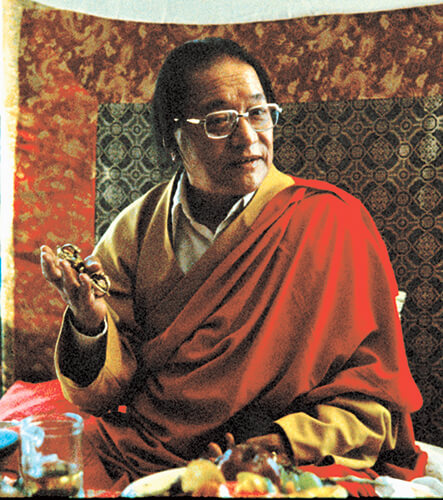
The benefits are immeasurable and are not accessible without a teacher. The great 20th-century master Dudjom Rinpoche gives some traditional examples to demonstrate the importance:
Ordinary, childlike beings are incapable of proceeding even vaguely in the same direction as the perfect path by the strength of their own minds, so they need first to examine and then to follow a qualified diamond master. Diamond masters are the root that causes us to correctly engage in the whole Buddhadharma in general and especially to follow the path properly. They are knowledgeable and experienced guides for inexperienced travellers setting out on a journey, powerful escorts for those who are travelling to dangerous places, ferrymen steering the boat for people crossing a river. Without them, nothing is possible. This is reiterated in countless scriptures.
Recently, there has been a lot of news and discussion in the media, Buddhist and otherwise, around the role of the teacher in Buddhism—in particular, Tibetan Buddhism. This mostly relates to a small handful of teachers (including the leader of Shambhala International, an organization totally unaffiliated with Shambhala Publications) against whom there have been serious allegations of abuse of power, some of it sexual. Many of these articles have been read by a younger generation of Westerners curious about Buddhism and other spiritual traditions but suspicious of hierarchy, organized religion, and spiritual leaders with perceived authority. This media attention seems to validate their suspicions.
But however bad some of these cases are—and it should go without saying that someone who is causing harm is acting in complete opposition to the Buddhadharma—a teacher harming or taking advantage of a student is an unacceptable exception to the norm; it is a rare aberration in an incredible system that has benefited millions of people East and West in the most profound and transformative ways.
These aberrations are not new. People are human, and throughout Buddhist history (or any tradition) there has been the occasional charlatan or flawed leader—as the discussion of how to avoid a bad teacher in many of the texts below make plain. But the fact is that there are so many highly educated, spiritually accomplished (typically following many years in retreat), caring, selfless teachers in this tradition, and it is a shame that people who do not know better are being exposed, online and in print, only to the exceptions rather than the norm and the potential.
Specifically, much of the recent coverage and discussion online and in print around the role of the guru or lama has reflected a deep misunderstandings of the role of the teacher in Tibetan Buddhism and has therefore created a lot of confusion. The best way for a student to find the right teacher who can lead them far along the path to enlightenment is to have a solid ground in understanding what the roles are, to be aware of the cultural dynamics at play, and to know which qualities to seek and which to avoid.
So, we are pleased to share this Reader’s Guide to help those interested in understanding the role, importance, and centrality of the guru or lama and the transformative power of the student-teacher relationship. We hope this will better prepare those pursuing this path to understand the choices they are making and set them up for spiritual success and accomplishment.
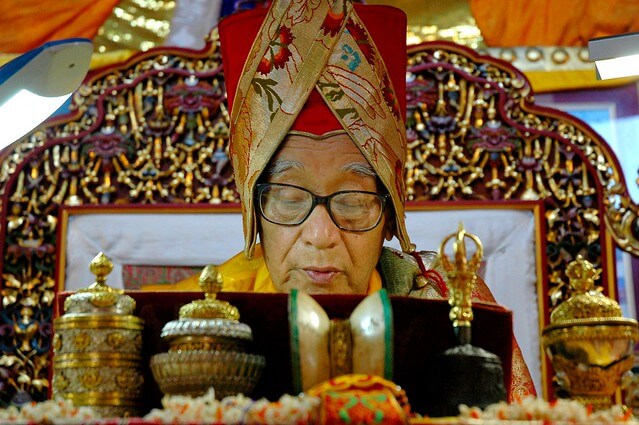


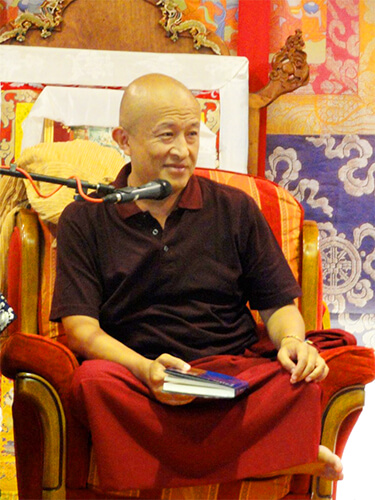
Perhaps the book that addresses head-on the contemporary concerns and confusion about the role of the teacher—from gender inequality to power dynamics and bad apples—is Dzongsar Khyentse Rinpoche’s The Guru Drinks Bourbon. This is a thrilling modern guide to help students understand what they are in for and what is expected of them. It is, after all, a two-way street. He covers many areas and, while acknowledging a checklist is too simple of a model, he does present some helpful guidelines.
“The good guru
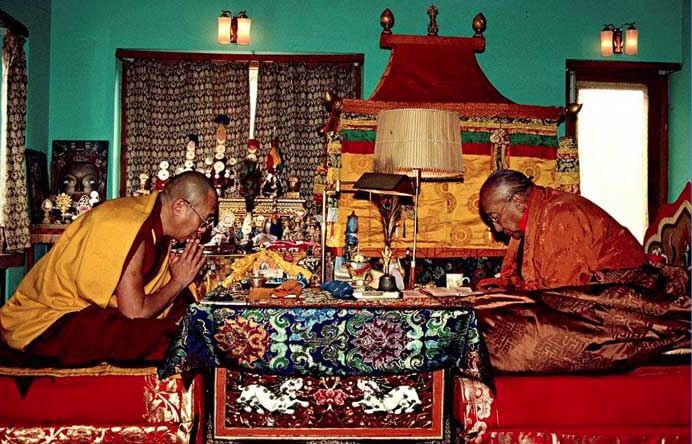

Another book exploring the student-teacher relationship is Alex Berzin’s Wise Teacher, Wise Student: Tibetan Approaches to a Healthy Relationship. The work covers many of the traditional topics but also gives a lot of thought to contemporary issues, cultural differences, and Westerner-specific issues like paranoia and vulnerability. He brings in some models from psychology (transference and regression) to explain many of the dynamics Westerners may present and how students can overcome them.

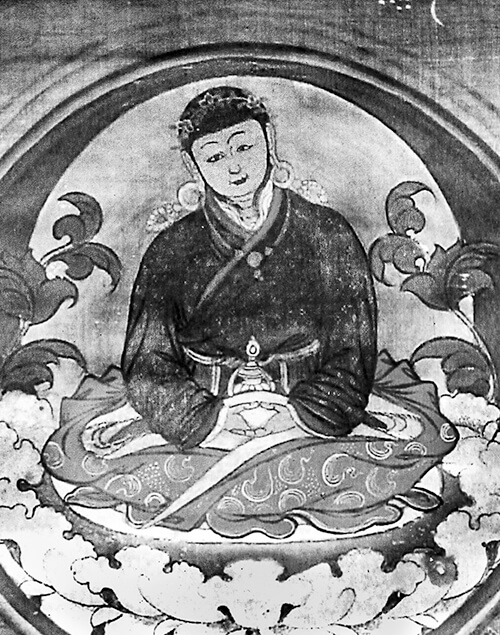
In general, although it is taught that there are six kinds of masters from whom you receive instruction, the masters who give the pith instructions are your root spiritual masters imbued with threefold kindness. Thus, no discourse or tantra relates a story of the attainment of enlightenment without that individual having relied upon a spiritual master. Each and every one of the highly accomplished masters who appeared in the past relied on material or nonmaterial spiritual masters, and developed all the qualities gained along the paths and stages of awakening; this is a matter of record. Therefore, your lamas have exhausted any flaws and have perfected all qualities: your lamas are the Buddha incarnate. Yet the mind-streams of us ordinary individuals are easily influenced by such things as conditions in our country, our historical period, or our companions. We must thus begin by examining spiritual masters from vantage points both close by and distant, then rely on them having set aside our negative thoughts or attitudes. In the end, having offered service by pleasing the lamas in three ways, and having kept tantric bonds without allowing them to be violated, we train so that our lamas’ wisdom mind and conduct are impressed upon us: our mind and conduct become like a clay image [satsa] emerging from a mold. This is very important.

Dudjom Rinpoche, mentioned above and one of the greatest masters of the 20th century, starts off his magisterial explanation of the foundational practices—A Torch Lighting the Way to Freedom: Complete Instructions on the Preliminary Practices, for those embarking on the path of Vajrayana Buddhism—with a long chapter titled “The Qualifications of Masters.”
He concludes it with:
Sublime teachers who are rid of all the faults just described and who possess all the right qualities are, because of the times, very hard to find—like the udumbara, the king of flowers. Even if they should happen to come across such teachers for just a little while, sentient beings with impure perception see faults in them—as has happened many times, starting with Devadatta who saw faults in the Bhagavan. Moreover, most people nowadays have the same store of negative deeds and misfortune, and so they perceive faults as good qualities and good qualities as faults. They see even those who have not a single ability that accords with the Dharma, whether manifest or hidden, as sublime beings, and so on. Those who know how to check are rare indeed. In particular, with regard to giving the profound teachings on the actual condition of things, teachers who have no realization cannot make the ultimate experience and realization develop in their disciples’ mindstreams. We should therefore take this point as a basis and regard a teacher who has most of the right qualities as the equal of the Buddha. The reason for considering even those in whom six of the above sets of qualities are complete and who have most of the right qualities as sublime beings and for following them is described in the Approach to the Absolute Truth:
Because of the age of strife, teachers have a mixture of faults and virtues:
There are none with no negative aspects at all.
Having carefully checked those who have more qualities,
Disciples should put their trust in them.
A Torch Lighting the Way to Freedom
$34.95 - Paperback
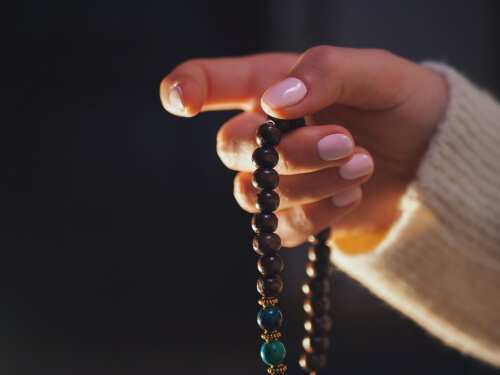
Whether our teachers present in person are ordinary beings or emanations of Buddhas or Bodhisattvas, if we are able to pray to them considering them as the Buddha, there is absolutely no difference between them and the Buddha or Bodhisattva or yidam deity in person, because the source of blessings is devotion. So whichever profound practice we are undertaking, whether the generation phase or the perfection phase, we should begin by making the teacher’s blessings the path. There is no more to it than that. But as long as we have not received the blessings, we will not be genuinely on the path. It is said that if disciples who keep the commitments give themselves wholeheartedly, with devotion, to an authentic diamond master, they will obtain the supreme and common accomplishments even if they have no other methods. But without devotion to the teacher, even if we complete the approach and accomplishment practices of the yidams of the six tantra sections, we will never obtain the supreme accomplishment. And we will be unlikely to accomplish many of the ordinary accomplishments either, such as those of long life, wealth, or bringing beings under one’s power. Even if we do manage to achieve a little, it will have necessitated a lot of hardship and will have nothing to do with the profound path. When unmistaken devotion takes birth in us, obstacles on the path will be dispelled and we will make progress, obtaining all the supreme and ordinary accomplishments without depending on anything else. This is what we mean by the profound path of Guru Yoga.
A Torch Lighting the Way to Freedom
$34.95 - Paperback

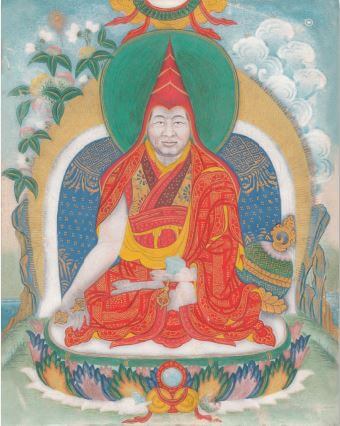
“There is one single criterion you should particularly check when examining a teacher: it is whether he has bodhichitta. If he has the bodhichitta, whatever sort of connection one makes with him will be meaningful. A good connection will bring buddhahood in one lifetime, and even a negative connection will eventually bring samsaric existence to an end.”
While one may not be so confident in their bodhicitta detection skills, the point is, after studying and analyzing the teacher, to use your own judgement.
If you wanted more detail, the author presents a more descriptive list of what characteristics to look for.
There are many other traditional overviews that include key instructions for evaluating, committing to, and following a teacher. From the tradition His Holiness the Dalai Lama was first educated in, Tsongkahpa’s The Great Treatise on the Stages of the Path to Enlightenment covers the subject over several pages. The great 18th-century adept Jigme Lingpa’s Treasury of Precious Qualities beautifully covers this as well.
A Guide to The Words of My Perfect Teacher
$34.95 - Paperback


Kongtrul relies on sutra and tantra sources to explain each of these. The reader will put it down having a much better appreciation for the scope of the Vajra master and student’s responsibilities, neither of which can be taken lightly.
The Teacher-Student Relationship
$24.95 - Paperback
By: Jamgon Kongtrul Lodro Taye & Ron Garry & Ven. Gyatrul Rinpoche & Lama Tharchin

Dangerous Friend: The Teacher-Student Relationship in Vajrayana Buddhism by Rig’dzin Dorje focuses exclusively on the Vajrayana aspects of the teacher-student relationship.


Many people are suspicious of Buddhism in general and particularly of the Vajrayana because of the intensity of the guru-disciple relationship. They are made uncomfortable by the level of projections that occur in the interaction of teacher and student. They do not like the lack of explicit restrictions, rules, and limitations on the relationship. They would prefer clear expectations and boundaries, without the uncertainty and intimacy that Vajrayana Buddhism implies.
Without denying the dangers in this as in all other intimate human relationships, and acknowledging that there can be no complete guarantee against mistakes and abuses, still there would appear something shortsighted in this point of view. As long as human beings live in the realm of samsaric duality, there is the inevitability of projection—in this case the positive projections of seeing something ‘‘out there’’ to which we are attracted and that we feel we need. What is sometimes not sufficiently realized is that no human beings are outside of this cycle.
Moreover, projection of this nature is not an inherently bad or undesirable thing. In fact, it is only because we are willing to project, willing to seek our dreams, that we can come up short and begin to integrate the part of ourselves that we had at first seen as outside. People do get ‘‘stuck,’’ but usually not forever. This process always involves vulnerability and suffering, but only in a culture that abhors pain and equates it with evil can one fail to see the transformative element.
The Vajrayana operates by eliciting and provoking the projections of our own deepest nature, then forcing us back on ourselves so that we have to integrate and take possession of those projections. This process is seen no more clearly than in the relation of teacher and student that forms the backbone of the path. Trungpa Rinpoche comments that at the beginning of the path, the teacher is seen virtually as a demigod. In the middle, he is experienced as a friend and companion. And at the end, when we have attained the state of realization that we once saw uniquely in him, he becomes inseparable from the inborn, living wisdom within.
What is sad is not to see this process of projection in Buddhism, where it can lead to something dignified and noble, but to see the way that it operates in the contemporary ‘‘modern’’ world, where it so often leads to an utter dead end. Here, people project their deepest yearnings onto things that have little to do with the human spirit and its maturation—new cars, upscale houses, clothes, vacations, credentials, fame, wealth, and power. It is not surprising, for example, that it is often among those who have succeeded most fully in realizing the materialism of the American Dream that one can find the most emptiness, fear, and unacknowledged despair.
Another way to approach this is simply to read the stories of great masters and be inspired by their example. Here are a few places to get started:
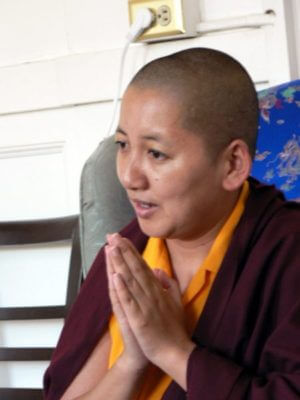
Khandro Rinpoche
Khandro Rinpoche discusses her teachers in her expansive Refuge chapter in This Precious Life: Tibetan Buddhist Teachings on the Path to Enlightenment
The incomparable lamas of the Longchen Nyintig tradition are presented in Tulku Thondup’s Masters of Meditation and Miracles.
The inspiring stories of Patrul Rinpoche are the subject of Matthieu Ricard’s collection of the oral history of this essential figure, Enlightened Vagabond.
The archetype of students, Milarepa, can be read about in many of the books included in our Reader’s Guide on him.
A subsequent article will address the related topic of Guru Yoga, which lies at the heart of the Vajrayana.
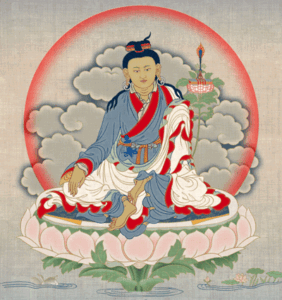
Dzongsar Khyentse on the Meaning of Empowerment

From the Snow Lion Newsletter Archive:
What actually happens when we receive an empowerment? Here, Dzongsar Khyentse Rinpoche helps us to understand a little about it, in this adaptation from Entrance to the Great Perfection: A Guide to the Dzogchen Preliminary Practices, a compilation created by Cortland Dahl.
The term “empowerment” derives from the Sanskrit word “abisheka.” Sanskrit is an exceptionally rich language, especially when it comes to the nuances of each individual word. Since one word can contain several levels of meaning, we can end up with different interpretations. That is the beauty of Sanskrit.
The term “empowerment” has two primary meanings. In Tibetan, we refer to these two meanings with the words torwa and lugpa, which can be translated as dismantling and pouring, respectively. In this case, “dismantling” refers to dismantling the cocoon, or shell, of ignorance. “Pouring,” on the other hand, refers either to pouring the blessings, or pouring/discovering buddha nature.
When it comes to understanding the implied meaning of empowerment, however, the terms we use can actually be misleading. To interpret the word “empowerment” to mean “pouring” and “discovering,” and even when we use the expression “receive an empowerment,” can inadvertently lead us to think we are being given a power that was previously not in our possession. The term “empowerment” almost has the connotation of conferring something, not unlike a knighting, for instance.
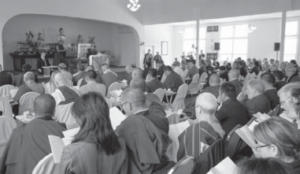
This interpretation is far from the true spirit of the tantric initiation. In being empowered, one is being introduced to something within oneself, albeit something that has gone unrecognized. Activating this recognition is what we mean by the term “empowerment.”
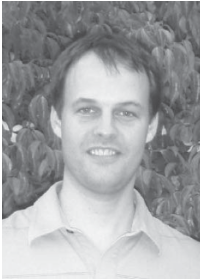
Cortland Dahl
There are various empowerments with numerous divisions, yet according to the highest yoga tantra, there are four main types. Each of these four, referred to as the “four empowerments,” is designed to dismantle one of the four defilements. These four are the defilements of nadi, which relate to the veins, chakras, or channels; the defilement of prana, which coincides with speech, or wind-energy; and the defilement of bindu, which is a defilement of mind. There are two ways to explain the fourth defilement: one is to say it is the residue of the three combined or, in other words, something similar to alaya. Alternatively, it can be described as “the ground of everything,” but this second way of explaining it is quite difficult to understand.
The empowerment ritual utilizes symbolic implements and substances. First, the guru will place a vase on your head and then pour some liquid into your hand, saying, “Drink this saffron water.” Next, the guru will use a kapala, which is traditionally filled with nectar. This substance is actually a mixture of the father and mother consort’s essence. These days, however, most of lamas use Bordeaux or Chianti if the empowerment is given in Europe, or tequila if it is being given in America. With the third empowerment, the substance is related to the consort. Nowadays, lamas will flash a picture of a dakini or something similar. Finally, for the fourth empowerment, which is referred to as the word empowerment, a substance like crystal is sometimes used, though technically speaking this is no longer a necessity. The crystal symbolizes the nature of mind.
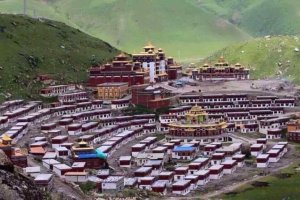
Dzogchen Monastery & the Dzogchen Rinpoches
| The following article is from the Spring, 1990 issue of the Snow Lion Newsletter and is for historical reference only. You can see this in context of the original newsletter here. |
It is of the greatest simplicity. It is what is. Dzogchen, which is beyond conceptions and transcends both grasping and letting go, is the essence of transcendental insight. This is the unchanging state of non-meditation in which there is awareness but no clinging.
Jikme Lingpa, The Lion's Roar

The first Dzogchen Rinpoche, Pema Rigdzin, was born in Kham Riwoche in Eastern Tibet in 1625. He overcame great difficulties in order to study with about thirty masters. He was ordained by the 5th Dalai Lama, thereby creating the close link between the Dalai Lamas and the Dzogchen Rinpoches which was to endure over the centuries to follow. Pema Rigdzin spent much of his life in retreats, which included one seven-year retreat on one seat and from one to three years in many other places, and he became renowned all over Tibet. Once when he was giving him an empowerment, his master Bakha Tulku, realizing the depth of his attainment, said: I have heard of Dzogpachenpo as a teaching, but I have never seen Dzogpachenpo as a person except in you. It was from then on that he became known as Dzogchen Pema Rigdzin, Dzogchen Rinpoche.
In the latter part of his life, he was summoned by the Dalai Lama, who told him that he believed he was, without any doubt, the reincarnation of Tsongkhapa, who had vowed to serve the Nyingma School in a future life. With that he instructed him to go and found a Nyingma monastery at Dzachukha in Kham. Dzogchen Rinpoche set out for Kham with his two greatest students, and when they came to the site of the future monastery, it was just an empty valley with a few nomads. To this day, the stone on which Dzogchen Rinpoche first rested still bears the imprint of his body. As he sat, undecided as to where to build the monastery, he put out a small protector's offering, whereupon a crow flew down, took the offering in its beak and threw it. The spot where it landed marked the site of the Dzogchen monastery.

Photo of Dzogchen Moansery in Tibet more recently from Wikimedia Commons
The fame of Dzogchen Rinpoche attracted students from all over Tibet, and with the help of the King of Derge, the monastery was completed over the years 1684-5. Dzogchen Pema Rigdzin passed away at 73, in 1697. The monastery he founded, called Dzogchen Rudam Orgyen Samten Choling, was destined to become the largest Nyingmapa monastery in Kham. It was situated in the Tudam Kyitram Valley, in Kham Derge on the border with Lingt-sang, the birthplace of the great Tibetan warrior-king Gesar. The site is counted as one of the twenty-five great pilgrimage sites of the Kham region, and the main one associated with the noble qualities of the Buddhas. Nearby lie three sacred lakes, and the cave where Padmasambhava first compounded myrobalan medicine.
It was in Mongolia that the Second Dzogchen Rinpoche Gyurme Tekchok Tenzin was born in 1699. He became a realized master of Dzogpachenpo and took a special interest in the Buddhist scriptures, copying the whole one hundred and eight volumes of the Kagyur (the Word of the Buddha) by hand. It was when the king of Derge found him alone copying the Kagyur that he was moved to establish a printing press at Derge to produce the Kagyur and Tengyur. The Second Dzogchen Rinpoche himself founded the printing press at Dzogchen, which later became one of the most well-known in Tibet. At the behest of the King of Derge, he published the writings of Longchenpa (1308-63), such as the Seven Treasuries, the Trilogy of Finding Comfort and Ease, and his great commentary on Guhyagarbha Tantra.
Dzogchen was now almost like a city in size, and famous for the Shedra and retreat centers that produced and attracted countless renowned scholars and masters of meditation. Among them was the great Patrul Rinpoche, who rose to fame as a scholar and Dzogchen master, poet and author, and played a leading part in the 19th-century renaissance of Buddhist culture and spiritual life in Tibet. His free spirit led him away from a monastic lifestyle, and he preferred to stay in retreat, travel or live amongst beggars. Scholars from all four schools of Tibetan Buddhism and Bon came to study with him.
Mipham studied at Dzogchen Shedra too, especially under Patrul Rinpoche. Famous for his original commentaries on important Buddhist scriptures, which were used as textbooks in colleges all over Tibet, he also wrote on many subjects. His printed works alone came to over thirty-two volumes.
Jigdral Changchub Dorje, the Sixth Dzogchen Rinpoche, was born in Tsari in 1935. Under the tutorship of Khenpo Gonri, he was already a master in whom many saintly qualities were seen, such as being able to foretell the unseen and leave imprints of his hands and feet in solid rock. He received teachings from a number of masters, including Jamyang Khyentse Chokyi Lodro, and was granted the title of Qutuktu by the Government of Tibet, the highest spiritual honor. He devoted all his resources and energy to furthering the Buddhadharma, encouraging the study of specific teachings, continuous ceremonies and cycles of practice in the study and retreat centers. Among a number of important images he constructed at Dzogchen was a three-dimensional Copper Coloured Mountain (Padmasambhava's paradise) made of various precious gems.
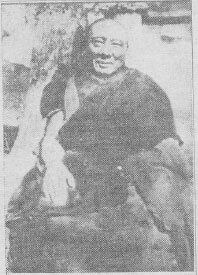
During his time, the lamas and monks at Dzogchen monastery numbered over a thousand, and it had over two hundred and fifteen branch monasteries. Dzogchen monastery had perhaps the best scriptural college and retreat center in the Nyingma and Dzogchen tradition. It was also famous for its sacred dances, to which people would flock from far and wide.
In 1959 Dzogchen monastery was razed to the ground by an occupying Chinese force, and Dzogchen Rinpoche, along with the majority of the lamas and monks, was killed. Barely half a dozen of the monks from Dzogchen managed to escape into exile.
The Seventh Dzogchen Rinpoche, Jikme Losel Wangpo, was born in Sikkim in 1964. He was recognized by the 4th Dodrupchen Rinpoche and enthroned in 1972. Among the other great Lamas from whom he has received teachings are H.H. Dudjom Rinpoche and Dilgo Khyentse Rinpoche, and his education has been very closely and personally supervised by His Holiness the Dalai Lama, who feels very strongly that link between himself and Dzogchen Rinpoche created during the time of the Fifth Dalai Lama. The present Dzogchen Rinpoche has long been regarded in India as being a great teacher of the future, showing remarkable qualities-profound intelligence and inner awareness along with quiet dignity and humility. In 1985 and in 1988, at the invitation of Sogyal Rinpoche and Rigpa Buddhist Meditation Centers, he made his first visits to the West.
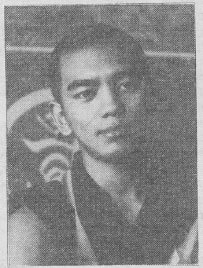
According to the directions of H.H. the Dalai Lama, the Dzogchen Monastery is being rebuilt in Kollegal, Mysore, South India, were it will become a major center for the Nyingmapa teachings. His Holiness considers this of very great importance, granting the site for the monastery close to his own residence. Already monks have enrolled and the monastery serves as a focus for the large Tibetan community, catering to its spiritual and educational needs.
Dzogchen monastery will become a major focal point for the Nyingmapa teachings, and will reestablish the great living tradition of Dzogchen, where both study and practice are equally emphasized. The most important phase of the development of the monastery is to establish a study college (Shedra) modeled on the famous Shri Singh Shedra' of the original Dzogchen monastery. Provision of teachers and facilities for study are of crucial importance for the young monks who have joined the monastery. Four salaried teachers provide a well-rounded education and instruct the monks in the traditional branches of learning. At present all the monks receive lessons in the one room of the kitchen/dining hall, which having only just been constructed, lacks any fittings or installations. As long as the hall is used for classes, it cannot be used for its original purpose.
The total construction of the Shedra, including building materials, is just over 100,000 rupees (approximately $58,600).
Water Tank Dzogchen monastery is located in a particularly dry area of southern India, where scarcity of water is a major problem. At the moment an old pipe supplies a very limited amount of water from the nearby hills, but it is not even sufficient for washing. Building construction requires a great deal of water and currently this can only be arranged with enormous difficulty. New toilets and bathrooms have been completed but owing to the water shortage these facilities cannot be used. The monastery badly needs an adequate water supply which can be provided through the installation of a water tank. The cost of the water tank is 15,000 rupees or $900.
Sponsorship Individual sponsorship for the fifty resident monks is required to ensure their continued training. For $20 a month a monk can be fully supported in his training and education. For full details on the sponsorship program and other projects contact Rigpa Fellowship, P.O. Box 7866, Berkeley, CA 94707. Tel.408-688-2535.

